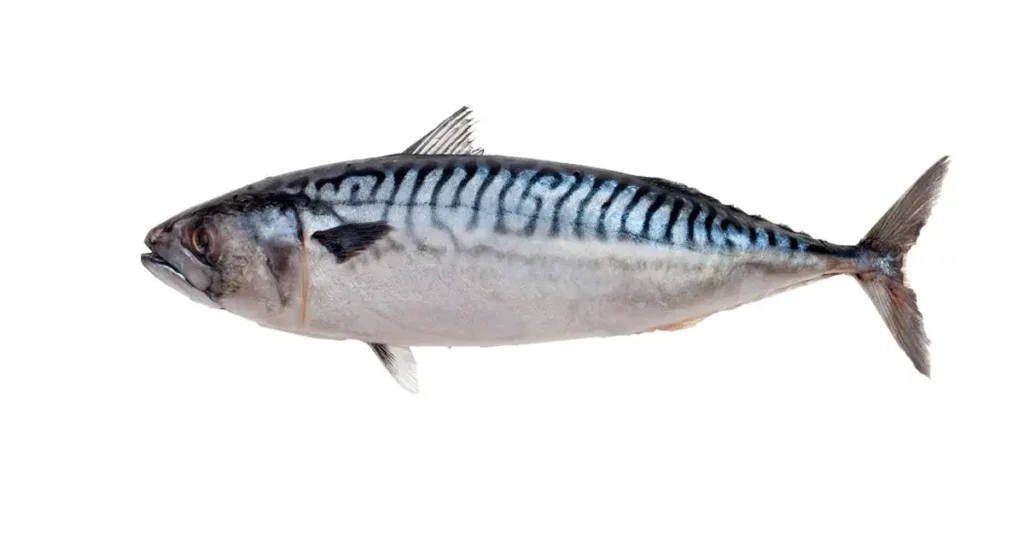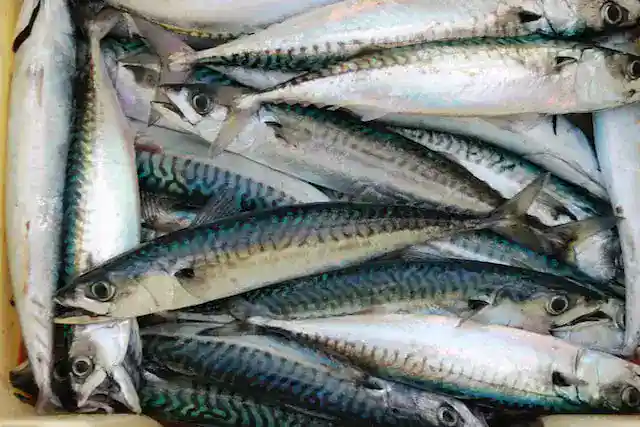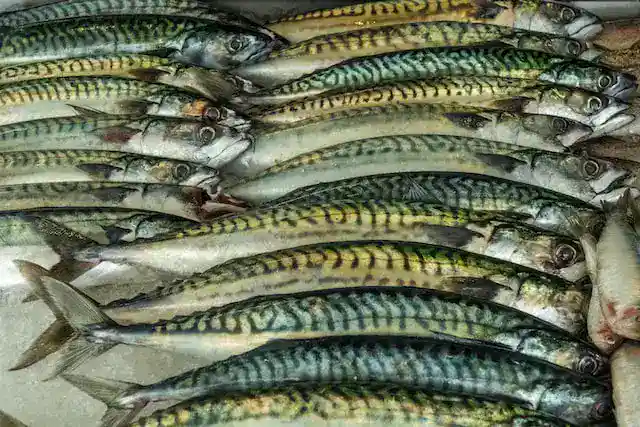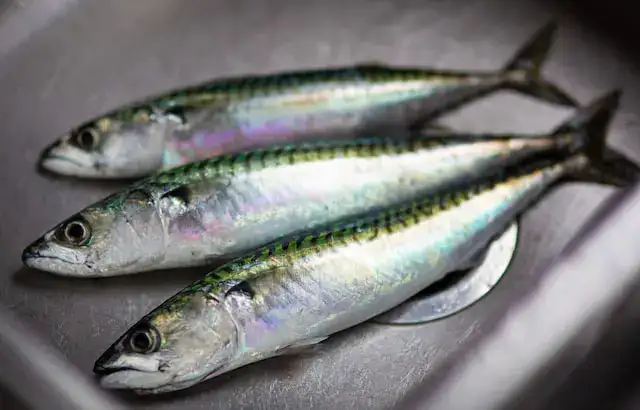In the below post, you will learn about all details of Mackerel fish like – Mackerel fish in Tamil, its 9 types, nutritional value, 7+ benefits, availability, supply, photos, recipes and many more.
Mackerel is an oily fish full of omega-3 fatty acids, and it is consumed all over the world. This seafood is commonly used in so many Indian food cuisines. In India, it is widely known as Indian mackerel or Bangada fish.
If you are into fitness and eat healthy food, then mackerel is a good option which is full of protein and low in calories. You can get this tasty fish at a reasonable price, readily available in any local market. Mackerel is the central cuisine of the southeast and Southeast Asian people.

Kembung, bangude, bangada, aiyla meen, and aiyla are some other names of Indian mackerel. The availability of mackerel fish in the Indian Ocean and Western Pacific ocean is widespread. It is primarily found in shallow water. It is also found in Melanesia, Ryuku, Samoa, Australia, the Red Sea, China, and Africa.
| Mackerel Fish in Tamil Name | Kanangeluthi |
| Scientific name | Mackerel fish |
| family | Scombridae |
| species | Pelagic |
| kingdom | Animalia |
| phylum | Chordata |
| subfamily | Scombrinae |
| order | Scombriformes |
| class | Actinopterygii |
| genus | Rastrelliger |
Mackerel fish in Tamil name
Kanangeluthi is the mackerel fish in Tamil name. Vanjaram is the common name of king mackerel in Andhra Pradesh and Tamil Nadu. You can get this fish from both tropical and temperate seas. Their favorite place to live is offshore or on the coast in the ocean.
Mackerel fish is one of the fishes commonly consumed by Indians and widely available in most Indian regions, mainly in Kerala and Tamil Nadu. King mackerel or Vanjaarm is a little expensive in Tamil Nadu.
Product of Mackerel Fish
Click here to see product of mackerel on Amazon
Health benefits of consuming mackerel fish
Mackerel fish offers various health benefits, whether it is canned or fresh. Here we are going to discuss some health benefits of eating mackerel fish –
1. It helps to develop the heart’s health in adults
Mackerel consists of polyunsaturated fats like EPA, DHA, and omega-three fatty acids, which can help avoid the risk of cardiovascular disease and save a human from death. Supplements from fish oil decrease cholesterol levels and lower triglycerides.
According to a dietician, you can consume two mackerel fish servings in a week. The excellent fat of omega three fatty acids helps to control blood pressure. If you have low blood pressure, your heart does not need to work hard for blood circulation. Low cholesterol level leads the arteries of your heart to fat build-up. By following the dietician’s advice, you can keep your heart healthy.
2. Controls brain disorder
DHA has a significant role in brain development. It is possible due to omega-3 fatty acids in mackerel fish. It helps maintain the human brain’s balance and controls the chemical messenger. Doctors also advise intaking mackerel fish because it can decrease mental health issues like bipolar disorder, depression, and autism.
3. It helps to make bones strong
Various nutrients in mackerel fish can lead you to healthy bones. The most important substance is vitamin D. it helps in the metabolism of two minerals essential for bone growth. Those are calcium and phosphorus. If your body has sufficient vitamin D, then there is a low risk of bone fracture and loss. To maintain the density of bone, mackerel fish has selenium and copper.
4. Decrease cognitive decline with increasing age
By eating different kinds of seafood like mackerel fish dishes, you can control the cognitive decline due to aging. The DHA and EPA in mackerel fish help boost the cognitive function of Alzheimer’s patients with mild symptoms.
5. Boost the journey of weight loss
Mackerel fish contains a good quantity of healthy proteins and fats. The hunger hormone that helps to high your interest in eating is known as ghrelin. Proteins and fats help to decrease the ghrelin level as compared to carbohydrates. Mackerel is a high-protein food that keeps you full for a long time. It leads to a proper diet without overeating and maintaining body weight.
6. Decrease the type 2 diabetes risk
As per some studies, it is a fact that high consumption of saturated fish can lead to type – 2 diabetes. But you can reduce the risk factor by eating polyunsaturated fat. Mackerel fish has omega-3 fatty acids, which are polyunsaturated. So by intaking it, you can prevent diseases and maintain your overall health.
7. Help to avoid anemia
To prevent anemia, and you can get good nutritional value from mackerel fish. Anemia causes due to nutrition deficiency. The fish contains vitamin B12, some folate, and iron. Some symptoms of anemia include disturbed vision, muscle weakness, infertility, and extreme tiredness.
Types of mackerel fish
The Scombridae family has more than 30 different types of mackerel fishes. Although there are other species in the family, they have common characteristics. Names of some mackerel fishes are – king mackerel, cero mackerel, Atlantic mackerel, Indian mackerel, chub mackerel, Atlantic Horse mackerel, blue mackerel, broad-barred king mackerel, narrow-barred Spanish mackerel, Pacific jack mackerel, Island mackerel, Atlantic chub mackerel, Atlantic Spanish mackerel, blue jack mackerel, greenback horse mackerel, cape horse mackerel, Cunene horse mackerel, Chinese mackerel, Chilean jack mackerel, Carangidae, wahoo, butterfly kingfish, short mackerel.
1. King mackerel
It is known as the giant migratory mackerel. Along the Atlantic coast, King mackerel fish inhabit the water to Brazil from the Bay of Bengal. Most sports people love to eat mackerel fish.
The ideal size is approximately 1.5 feet to 2 feet, and the weight could be 1 kg to 2 kg. The fish has a streamlined body with a forked tail and taper head. Its back is blue, its belly is steely-gray, and its sides have a hint of rose color. Many mackerel have spotted bellies, but king mackerel have no spotted belly, with some faint yellow spots at the back of juveniles.
2. Spanish mackerel
Its dorsal fins are deep black, and its back is teal like king mackerel, but the Spanish mackerel has a comparatively small body. At the length of 15 to 20 feet, their weight is around 1 to 2 kg. It has some gold color spots on its back, making it distinguishable from others. The marks are more visible than the king Mackerel fish spots.
3. Cero mackerel
The average length of a cero mackerel can reach up to 12 – 20 inches, and the weight can be 2 to 3 kg. Its belly is iridescent silver, and the back is greenish-blue. You also find pink streaks barely on the lighter areas. On the length of their bodies, cero mackerel has iridescent bronze or yellow strips.
Tit love to live in tropical and warm water. It generally consumes smaller fishes and shrimps. It is in between the size of king mackerel and Spanish mackerel fish. So people typically misunderstand it.
4. Atlantic mackerel
You can find this species at the approximate length of 1 foot to 1.5 feet and weight at 0.5 kg to 1.5 kg. Its body has a forked tail and tapered head with streamline. Above the lateral line of its body, it looks metallic blue, and below the body or its belly part is pearly white. The back of the Atlantic mackerel has black bar marks, which look like zebra stripes.
5. Sierra mackerel
The Pacific ocean surface is the living space of sierra mackerel. They love to live in warm water. Mexican sierra is their other known name. They can grow to 8 inches and weigh up to 0.5 to 3 kg.
A deep greenish-bronze color is found along the dorsal area of sierra mackerel. Generally, they have a black dorsal fin and a colored fin similar to orange, like the ventral part of their body. They eat anchovies with the help of their sharp teeth.
6. Chub mackerel
Because of their zig-zag black bars over the body, they look like Atlantic mackerel fish. These bars are less visible than Atlantic mackerels. Their back is silvery-green in color. White or silver is the color of their belly.
They can grow up to 8 to 15 inches, and their weight goes from around 1 kg to 2 kg.
This mackerel species have a forked tail and large eyes. The Chub mackerel tail has tips and a black outline. During their adulting period, they move to deeper water from the shoreline.
7. Atlantic horse mackerel
This mackerel species prefer to live in the northern Atlantic ocean cooler water. It is one of the big fish of the family. Its average length is around 10 inches, but some grow up to 2 feet, and its approximate weight is approximately 1.5 kg.
Atlantic horse mackerel has a forked tail, tapered body, and oversized head. The color of its back is champagne which has a little greenish tint. It has a silvery green belly. Behind its eyes, it has a black gill spot. It is mainly used for commercial purposes.
8. Wahoo mackerel
Wahoo mackerel have different appearances, making them different from other mackerel family fish. Their strongness and speed make them very popular. They have elongated bodies with slenderness. Generally, they are blue, and vertical stripes are all around the fish.
They are found on both subtropical and tropical American coasts. Their length can go up to 5 to 6 feet. They have serrated and powerful teeth.
9. Indian mackerel fish
Compared to its counterpart of Atlantic, Indian mackerel is much larger. Mainly people of Southern Asia parts and Indian people heavily depend on the mackerel species as a source of food. You can prepare it by extracting its digestive tract and head.
Nutritional value of Mackerel fish
Nutritional value of mackerel fish ( 100 grams serving ) –
| Nutrients | Amount |
|---|---|
| Potassium | 314 |
| Selenium | 44.1mg |
| Protein | 19 gram |
| Magnesium | 76 mg |
| Calories | 205 |
| Sodium | 90mg |
| Fat | 13.9 gm |
| Omega – 3 fatty acids | Docosahexaenoic acid (DHA) – 0.59 grams Eicosapentaenoic acid (EPA) – 0.43 grams |
| Less known omega – 3 fatty acids | Docosapentaenoic acid (DPA) – 0.18 grams |
The fish contains no sugar, fiber, or carbohydrate.
Carbs
fresh raw mackerel fish has no sugar, fiber, or carbohydrate. But you may find some amount of carbohydrates in processed or breaded mackerel.
Fats
In 100 grams of mackerel serving, you can get 14 grams of fat. The saturated fat amount is 3.3 grams, the monounsaturated fat is around 5.5 grams, and the polyunsaturated fat is approximately 3.4 grams. It has different types of omega – 3 fatty acids. The amount of fat provided by Mackerel fish depends upon the area where it is caught.
Protein
Flesh of mackerel fish contains 19 grams of protein, macronutrients, and all essential amino acids in a 100-gram serving.
Minerals and vitamins
Mackerel fish is a good source of vitamin B-12 and Vitamin – D. a 100-gram serving provides 8.71 mg of vitamins. Consuming mackerel every day offers sufficient vitamins for an adult. It also includes magnesium, iron, niacin, vitamin B6, selenium, folate, and phosphorus.
After milk, oily fishes are good sources of nutrients. You can get the same amount of vitamin D from sunlight and mackerel fish.
Cost of Mackerel fish in Tamil telling area
The cost of mackerel fish is not that expensive. You can buy one kg of mackerel fish by spending around Rs 100 to Rs 700 in India. The people of the South and southwestern part of India love to eat Kanangeluthi meen and mackerel fish. The availability of mackerel in Kerala, Tamil Nadu, and other south Indian states are high. So you can purchase it in those areas quickly and at a minimum cost.
Supply of mackerel fish in Tamil areas
In the coastal belt of Karnataka and Tamil Nadu, the availability of mackerel fish is very high. The maximum quantity of mackerel comes from the west coast Island. The supply of mackerel all over India is operated from Bombay, Veraval, Cochin, Kolkata, Mangalore, and Karwar. These places obtain mackerel from the continental shelf’s deeper regions.
Famous Recipes of mackerel fish in Tamil areas
As we all know, mackerel is known as Ayala fish in Kerala. Some famous mackerel dishes are – Ayala Vatichathu or Ayala curry, Ayala fry, and Ayala curry with coconut milk. In Mangalore, the people used to cook Mangalorean mallu recipes using mackerel. Vajra fish fry is a famous mackerel fish recipe in Tamil Nadu people. They use king mackerel to prepare this recipe.
Depending upon the type of fish you are using, You can decide on the recipe. You can make sandwich filler by using canned mackerel. You can eat mackerel fish in the form of smoked, baked, fried, or grilled.
Some Mackerel Fish photos



Conclusion
Many countries adopt mackerel fish as a staple seafood in their diet. You can add mackerel to your diet because it is readily available and not that costly. It also provides various health benefits because it contains vitamins, good oil supplements, nutrients, and protein. It keeps your brain, heart, good fat, and bone healthy.
QnA
-
What are the benefits you can get by eating mackerel fish?
Mackerel fish contains good fats, critical fatty acids, and nutrients. It improves your skin, strengthens your bones, and properly regulates blood in your body to make the heart healthy. It prevents anemia and boosts the cardiometabolic system in children.
-
Which vitamins are present in mackerel fish?
Mackerel is primarily famous for its nutritional value and protein content. It has vitamin B12, vitamin B6, vitamin B3, vitamin B2, and vitamin D. The flesh of mackerel fish is an excellent source of minerals like selenium, iodine, and copper.
-
What are the types of Mackerel fishes?
You can find more than 30 different kinds of mackerel fishes in the Scombridae family. Some of those are – king mackerel, Spanish mackerel, cero mackerel, Atlantic mackerel, sierra mackerel, chub mackerel, wahoo mackerel, Atlantic horse mackerel, Indian mackerel, blue mackerel, jack mackerel, and many more.
-
Which mackerel fish is best among all?
Alaska mackerel and Atlantic mackerel are full of omega-three fatty acids, which help to fight against inflammation, and they have low mercury content compared to other varieties of mackerel fishes.
-
What is the taste of mackerel fish?
The flesh of mackerel fish has a lovely and sweet-salty taste. However, it is less expensive and can satisfy your taste buds with many health benefits. Its flesh is soft, moist, and flaky. But some people find mackerel a bit oily and fishy. It goes with many flavorful dishes because of its richness and sweet taste.
-
Describe the body structure of mackerel fish?
Mackerel fish has torpedo-shaped and round body with a forked tail, keeled tail base, and a slender tail. Behind its anal and dorsal fins is a row of little finlets.
-
What is the diet of mackerel fish?
Mackerel is a predatory fish. Its diet is fish eggs, mollusks, small fishes, crustaceans, and plankton.
| Fish | Common name | Scientific name |
|---|---|---|
| Spanih Mackerel | Bay or Spotted Mackerel | Scomberomorus maculatus |
| King Mackerel | Sierra or Cavalla mackerel | Scomberomorus Cavalla |
| Atlantic mackerel | Caballa or Boston mackerel | Scomber scombrus |
| Jack mackerel | Pacific Jack mackerel | Trachurus symmetricus |
| Atlantic Horse mackerel | European horse mackerel | Trachurus trachurus |
| Atlantic Chub mackerel | Tinker or small Chub mackerel | Scomber Colias |


Нey there! I’m at work browsing your blog from my new iphone 3gs!
Just wanted to say I love reаding your blog and look forward to all your posts!
Carry on the fantastic work!
keep reading.